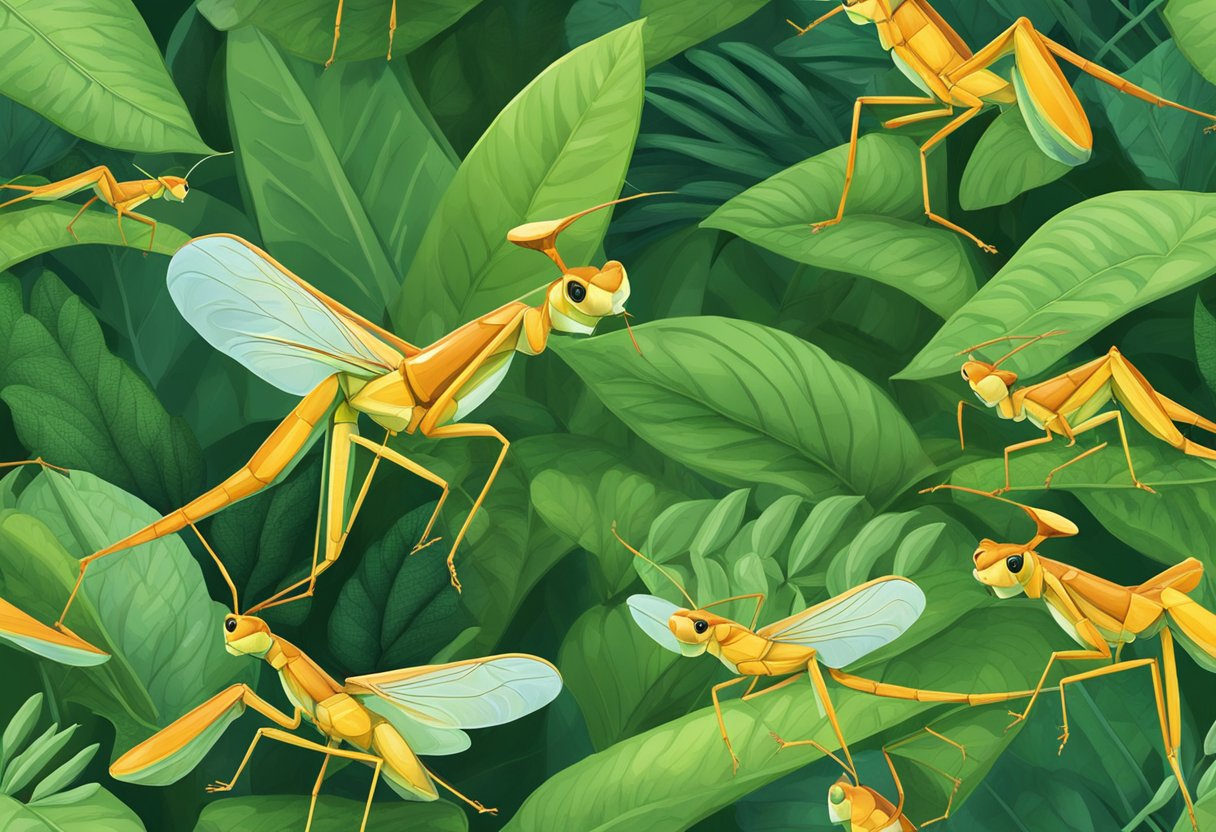Types Of Praying Mantises
Praying mantises are fascinating creatures that have fascinated people for centuries. These insects are known for their unique physical features and their predatory behavior. There are many different types of praying mantises found around the world, each with its own unique characteristics and behaviors.
One of the most interesting things about praying mantises is their diversity of species. There are over 2,400 species of praying mantises found around the world, with new species being discovered all the time. These insects come in a wide variety of shapes, sizes, and colors, with some species growing up to six inches long.
Praying mantises are also known for their physical characteristics, which include their elongated bodies, triangular heads, and powerful forelegs. These forelegs are used to capture and hold prey, while the mantis’s sharp mandibles are used to tear apart their prey. In addition to their physical characteristics, praying mantises are also known for their behavioral patterns, which include their tendency to remain motionless for long periods of time before suddenly striking at their prey.
Key Takeaways
- Praying mantises are diverse insects with over 2,400 species found around the world.
- They are known for their unique physical characteristics, including their elongated bodies and powerful forelegs.
- Praying mantises are also known for their predatory behavior and tendency to remain motionless before striking at their prey.
Diversity of Species

Praying mantises are fascinating insects that come in a variety of shapes, sizes, and colors. In this section, we will explore some of the most interesting types of praying mantises.
Carolina Mantis
The Carolina Mantis (Stagmomantis carolina) is a common species found in North and South America. It is known for its green or brown coloration and can grow up to 2.2 inches in length. The Carolina Mantis is a generalist predator, feeding on a wide range of insects, including moths, flies, and grasshoppers.
Chinese Mantis
The Chinese Mantis (Tenodera sinensis) is one of the most well-known species of praying mantis. It is native to Southeast Asia but has been introduced to many parts of the world, including North America. The Chinese Mantis is typically green or brown and can grow up to 4 inches in length. It is an ambush predator, waiting patiently for its prey to come within striking distance.
European Mantis
The European Mantis (Mantis religiosa) is a species native to Europe and parts of Asia and Africa. It is typically green or brown and can grow up to 3 inches in length. The European Mantis is known for its distinctive “prayer-like” posture, which it adopts when resting or waiting for prey.
Orchid Mantis
The Orchid Mantis (Hymenopus coronatus) is a species native to Southeast Asia. It is known for its striking pink and white coloration, which allows it to blend in with the flowers it hunts on. The Orchid Mantis is an ambush predator, waiting for its prey to come within striking distance.
African Mantis
The African Mantis (Sphodromantis spp.) is a group of species native to Africa. They are typically green or brown and can grow up to 4 inches in length. The African Mantis is known for its aggressive behavior and will attack prey much larger than itself.
Giant Asian Mantis
The Giant Asian Mantis (Hierodula membranacea) is a species native to Southeast Asia. It is one of the largest species of praying mantis, growing up to 6 inches in length. The Giant Asian Mantis is an ambush predator, waiting for its prey to come within striking distance.
Ghost Mantis
The Ghost Mantis (Phyllocrania paradoxa) is a species native to Africa. It is known for its unique appearance, with a flat, leaf-like body that allows it to blend in with its surroundings. The Ghost Mantis is an ambush predator, waiting for its prey to come within striking distance.
In conclusion, praying mantises are a diverse group of insects that come in a variety of shapes, sizes, and colors. Each species has its unique characteristics and behavior, making them fascinating creatures to study and observe.
Physical Characteristics
Praying mantises are known for their unique physical appearance and behavior. They have a triangular head with two large compound eyes and three simple eyes located between them. They also have a long neck that allows them to move their head in different directions. Their front legs are modified for hunting, with sharp spines and a raptorial shape that allows them to grasp and hold onto their prey.
Camouflage Abilities
One of the most fascinating features of praying mantises is their camouflage abilities. They can blend in with their surroundings by changing their color to match the environment. This is achieved by the presence of chromatophores, which are cells that contain pigments that can be expanded or contracted to change the color of the mantis. Some species of praying mantises also have wings that are camouflaged to look like leaves or bark.
Unique Anatomy
Praying mantises have a unique anatomy that sets them apart from other insects. Their thorax is elongated and has a triangular shape, which allows them to rotate their head in a wide range of angles. Their abdomen is also elongated and has a flexible joint that allows them to move it up and down. They have spines on their legs that help them grip onto their prey, and their front legs are modified to be used as weapons.
In conclusion, praying mantises have unique physical characteristics that allow them to be successful predators in their environment. Their ability to camouflage themselves and their unique anatomy make them fascinating creatures to observe and study.
Behavioral Patterns
Praying mantises are fascinating creatures known for their unique behavioral patterns. Here are some of the most interesting behaviors exhibited by these carnivorous insects:
Feeding Habits
Praying mantises are carnivores that feed on a variety of insects and other small animals, including flies, moths, and grasshoppers. They are ambush predators that rely on their excellent vision and agility to capture their prey. Once they have caught their prey, they use their powerful front legs to grasp it and then deliver a lethal bite with their sharp mandibles.
Mating Rituals
Praying mantises are known for their unusual mating rituals, which often involve ual cannibalism. In some species, the female will eat the male after or even during copulation. However, this behavior is not universal and varies between different species.
Molting Process
Like all insects, praying mantises undergo a molting process as they grow and develop. During this process, they shed their exoskeleton and grow a new one. Molting can be a dangerous time for mantises, as they are vulnerable to predation while their new exoskeleton is still soft.
Overall, praying mantises are fascinating creatures with unique behaviors that make them masters of disguise and agile predators. Their varied diet and carnivorous nature make them an important part of many ecosystems.
Habitat and Distribution
Praying mantises are found in a variety of habitats around the world. They are known to inhabit grasslands, tropical rainforests, secondary forests, and primary forests. In addition, they can also survive in deserts, meadows, and open fields. There are over 2,400 species of mantises, and they are found on every continent except for Antarctica.
Native and Introduced Regions
There are about 20 species of praying mantises that are native to the United States. They are found in different regions of the country, including the Southeastern United States, California, and Arizona. Some species of mantises have been introduced to other regions of the world, where they have become invasive species. For example, the Chinese mantis (Tenodera sinensis) has been introduced to North America, where it is now found in many parts of the continent.
Adaptation to Environments
Praying mantises are highly adaptable to their environments. They have evolved to have unique physical and behavioral adaptations that help them survive in their habitats. For example, some species of mantises have evolved to blend in with their surroundings, making it easier for them to ambush their prey. The unicorn mantis (Pseudovates arizonae) is a species of mantis that is found in Arizona and California. It has evolved to have a horn-like protuberance on its head, which helps it blend in with the desert environment.
In conclusion, praying mantises are found in a variety of habitats around the world, and they are highly adaptable to their environments. There are many different species of mantises, each with their own unique physical and behavioral adaptations. Whether they are native to a region or introduced, these fascinating insects are an important part of the ecosystems they inhabit.
Role in the Ecosystem
Praying mantises are known for their unique appearance and predatory behavior. They are a crucial part of the ecosystem and play an important role in maintaining the balance of nature. In this section, we will discuss the different ways in which praying mantises contribute to the ecosystem.
Predation and Pest Control
Praying mantises are known for their predatory behavior, and they are highly efficient hunters. They feed on a variety of insects, including flies, mosquitoes, moths, and even other praying mantises. This makes them an important natural control for pests that can damage crops and gardens. They are also known to feed on spiders, which can help control spider populations.
Threats and Predators
While praying mantises are skilled hunters, they are also vulnerable to predators. Birds, bats, and even some rodents are known to prey on praying mantises. However, mantises have evolved several defense mechanisms to protect themselves. They are able to blend in with their surroundings, making them difficult to spot. They are also able to turn their heads 180 degrees, allowing them to keep an eye on potential predators.
In conclusion, praying mantises are an important part of the ecosystem, providing natural pest control and contributing to the balance of nature. While they face threats from predators, they have evolved several defense mechanisms to protect themselves.






